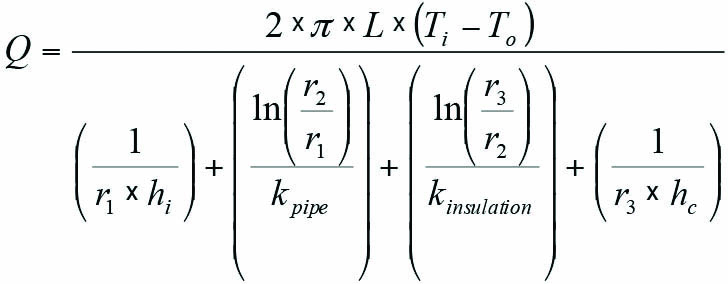Thermal insulation is installed on almost every piping system and much of the plant equipment at power generation facilities. It not only saves energy, but also helps protect against freezing, and more.
Thermal insulation is mainly used to limit heat loss from hot surfaces and heat gain on cold surfaces.

Basic Heat Transfer Calculations
Refer to this document:
Heat flows in the direction of the temperature gradient and the relationships governing heat flow depend on whether the heat transfer is occurring by conduction, convection, or radiation. These mechanisms for heat transfer are discussed below with sources of equations, such as the American Society of Heating, Refrigerating and Air-Conditioning Engineers (ASHRAE), appropriately noted.

Formula for Heat transfer through PLATE
Q = k x A x (T1 – T2) / X
where Q is the heat loss or gain (W or J/s); k is the thermal conductivity (W/mK); A is the area of heat flow (m2); T1 – T2 is the temperature difference (Deg.C); and X is the thickness of material (m).

Formula for Heat transfer through PIPE:
Q = k x A2 x (T1 – T2) / (r2 x ln (r2 / r1))
where Q is the heat loss or gain (W or J/s); k is the thermal conductivity (W/mK); T1 – T2 is the temperature difference (Deg.C); A2 is the area of the outer surface (m2); r2 is the radius of the outer surface (m), and r1 is the radius of the inner surface (m).
From above combination, we got the Formula for Heat transfer through PIPE with INSULATION:

where Q is the total heat loss (W or J/s); L is the length of pipe (m); Ti is the temperature of the fluid inside the pipe (Deg.C); To is the temperature of outside environment (Deg.C); r1 is the inside radius of pipe (m); r2 is the outside radius of pipe (m); r3 is the outside radius of insulation (m); hi is the inside film heat transfer coefficient (W/m2K); hc is the outside convective film heat transfer coefficient (W/m2K); kpipe is the thermal conductivity of pipe material (W/mK), and kinsulation is the thermal conductivity of insulating material (W/mK).
Still not finished, The Heat continuously transfers through to the AIR (from the Outside convective film, with consideration of air density, windy speed, ect.,)
Convective Heat Transfer and Radiant Heat Transfer from Outer Surface of Insulated Pipe. The convective heat transfer coefficient and the radiant heat transfer coefficient determine the heat loss or gain from the outer surface of the insulation (or pipe, if uninsulated) to the ambient atmosphere. The heat loss equation from the below equation:

The convective heat transfer coefficient (ho) for the outside air film can be calculated by several methods. The most common method is to use a correlation involving dimensionless numbers in the Nusselt equation in the following Nutsselt number form:

After calculated the accumulative heat transfer from inside to outside, we will calculate the average Leak Heat Flux through all the component (given area of heat transfer):

#SAMPLE OF INSULATION CALCULATION#
Within below insulated condition, is the Insulation THICKNESS sufficient for protecting the pipe from over HEAT-LEAKAGE requirement ( < 30W/m2 )
Piping nominal size = 6″
Piping external diameter = 152.4 mm
Piping length = 100 m
Insulation material = Polyisocyanurate
Insulation thermal conductivity = 0.023 W/mK
Assumed Insulation thickness = 60 mm
Piping external diameter (including insulation) = 152.4 + 2×60 = 272.4mm
Air Velocity = 5 m/s
Air Thermal Conductivity = 0.029 W/mK
Air specific heat = 1009 J/kgK
Air density = 1.038 kg/m3
Air viscosity = 0.02 cP
Now Calculation steps:
Step 1: Air Prandtle Number = 0.6959
Step 2: Air Reynolds Number =70687.8
Step 3: Overall Heat transfer Coefficienct = 18.096 W/m2K
Step 4: Piping In-leak heat = 2125.72 W
Step 5: Piping surface area = 85.58 m2
Step 6: Average heat flux = 24.8 W/m2 < 30 W/m2 –> The design is acceptable!!!


In the example calculation, what is the temperature of the air inside the pipe and outside the pipe?
LikeLike
You are proving very good and relevant information….
LikeLike